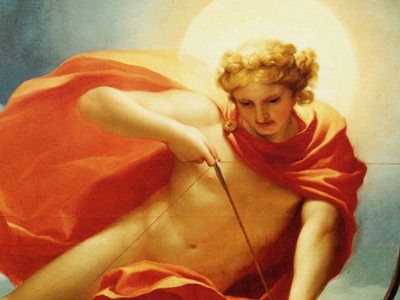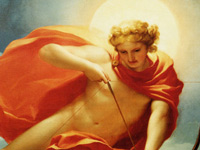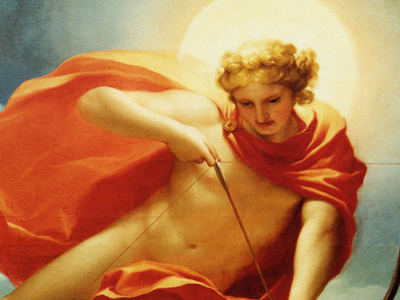Helios

Helios (/ˈhiːli.ɒs/; Ancient Greek: Ἥλιος Hēlios; Latinized as Helius; Ἠέλιος in Homeric Greek) was the personification of the Sun in Greek mythology. He is the son of the Titan Hyperion and the Titaness Theia (according to Hesiod), also known as Euryphaessa (in Homeric Hymn 31) and brother of the goddesses Selene, the moon, and Eos, the dawn.
Helios was described as a handsome titan crowned with the shining aureole of the Sun, who drove the chariot of the sun across the sky each day to earth-circling Oceanus and through the world-ocean returned to the East at night. In the Homeric hymn to Helios, Helios is said to drive a golden chariot drawn by steeds (HH 31.14–15); and Pindar speaks of Helios's "fire-darting steeds" (Olympian Ode 7.71). Still later, the horses were given fire related names: Pyrois, Aeos, Aethon, and Phlegon.
As time passed, Helios was increasingly identified with the god of light, Apollo. However, in spite of their syncretism, they were also often viewed as two distinct gods/titan (Helios was a Titan, whereas Apollo was an Olympian). The equivalent of Helios in Roman mythology was Sol.
Greek mythology
The best known story involving Helios is that of his son Phaethon, who attempted to drive his father's chariot but lost control and set the earth on fire. If Zeus had not interfered by throwing a thunderbolt at Phaethon, killing him instantly, all mortals would have died.
Helios was sometimes characterized with the epithet Panoptes ("the all-seeing"). In the story told in the hall of Alcinous in the Odyssey (viii.300ff.), Aphrodite, the consort of Hephaestus, secretly beds Ares, but all-seeing Helios spies on them and tells Hephaestus, who ensnares the two lovers in nets invisibly fine, to punish them.
In the Odyssey, Odysseus and his surviving crew land on Thrinacia, an island sacred to the sun god, whom Circe names Hyperion rather than Helios. There, the sacred red cattle of the Sun were kept:
You will now come to the Thrinacian island, and here you will see many herds of cattle and flocks of sheep belonging to the sun-god. There will be seven herds of cattle and seven flocks of sheep, with fifty heads in each flock. They do not breed, nor do they become fewer in number, and they are tended by the goddesses Phaethusa and Lampetia, who are children of the sun-god Hyperion by Neaera. Their mother when she had borne them and had done suckling them sent them to the Thrinacian island, which was a long way off, to live there and look after their father's flocks and herds.
Though Odysseus warns his men, when supplies run short they impiously kill and eat some of the cattle of the Sun. The guardians of the island, Helios' daughters, tell their father about this. Helios appeals to Zeus telling them to dispose of Odysseus' men or he will take the Sun and shine it in the Underworld. Zeus destroys the ship with his lightning bolt, killing all the men except for Odysseus.
In one Greek vase painting, Helios appears riding across the sea in the cup of the Delphic tripod which appears to be a solar reference. Athenaeus in Deipnosophistae relates that, at the hour of sunset, Helios climbed into a great golden cup in which he passes from the Hesperides in the farthest west to the land of the Ethiops, with whom he passes the dark hours. While Heracles traveled to Erytheia to retrieve the cattle of Geryon, he crossed the Libyan desert and was so frustrated at the heat that he shot an arrow at Helios, the Sun. Almost immediately, Heracles realized his mistake and apologized profusely, in turn and equally courteous, Helios granted Heracles the golden cup which he used to sail across the sea every night, from the west to the east because he found Heracles' actions immensely bold. Heracles used this golden cup to reach Erytheia.
By the Oceanid Perse, Helios became the father of Aeëtes, Circe, Perses (brother of Aeetes) and Pasiphaë. His other children are Phaethusa ("radiant") and Lampetia ("shining").
LEGENDS

RESOURCES
This article uses material from the Wikipedia article "Helios", which is released under the Creative Commons Attribution-Share-Alike License 3.0.
© Stories Preschool. All Rights Reserved.









